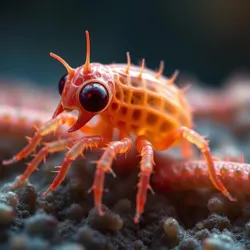Predators of the Invisible World
Predators of the Invisible World refers to a diverse group of microscopic organisms that play an essential role in maintaining ecological balance by preying on other microorganisms. These tiny predators are found in a range of environments, from the depths of the ocean to the extreme conditions of geothermal vents.
 An artist's rendering of a microscopic predator hunting in its environment.
An artist's rendering of a microscopic predator hunting in its environment.Overview
The concept of microscopic predators encompasses a wide variety of organisms, each adapted to hunt and consume other microscopic life forms. These predators are crucial for controlling microbial populations and recycling nutrients within ecosystems, ensuring the stability and health of their environments.
Types of Microscopic Predators
Protozoan Predators
Protozoans are perhaps the most well-known group of microscopic predators. These single-celled organisms exhibit diverse feeding strategies, such as engulfing their prey whole or using specialized structures to pierce cell membranes. They are often found in aquatic environments, where they play a critical role in regulating bacterial populations.
Viral Predators
While not traditionally considered predators, certain viruses act as natural predators by infecting and lysing bacterial cells. These viral predators, known as bacteriophages, have a significant impact on microbial communities and are vital for nutrient cycling.
Predatory Bacteria
Predatory bacteria, such as those found in the genus Bdellovibrio, are specialized hunters that prey on other bacteria. They invade their prey’s cell wall and consume the contents, effectively controlling bacterial populations and preventing harmful overgrowth.
Ecological Importance
Microscopic predators are an integral part of the Microbial Food Web, where they help maintain balance by keeping populations of bacteria and other microorganisms in check. This balance is essential for nutrient cycling and energy flow in ecosystems, particularly in environments like the Thermal Ecosystem, where Thermo Gliders and other extremophiles reside.
Research and Applications
The study of microscopic predators has broad implications for ecology, medicine, and biotechnology. Understanding their role in ecosystems can inform conservation efforts and strategies for managing microbial communities. Additionally, research into viral predators such as bacteriophages is advancing the field of phage therapy, a promising alternative to antibiotics.
See Also
- Heat-Resistant Microbial Ecosystems
- Thermo Gliders
- Extreme Environment Habitats
References
- "Microbial Predators and Their Ecological Roles," Ecological Microbiology Review, 2010.
- "The Invisible Hunters: Protozoan Predators in Aquatic Systems," Aquatic Ecology Journal, 2015.
- "Bacteriophages and Their Impact on Bacterial Populations," Microbial Dynamics, 2018.
Predators of the Invisible World are pivotal to the functioning of ecosystems, offering insights into the complexity and resilience of life at the microscopic scale. Their study not only enhances our understanding of ecological interactions but also holds potential for innovative applications in science and industry.